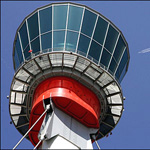Planes land while the air traffic controller sleeps

Federal aviation officials are reviewing air traffic controller staffing at airports around the country after two airliners landed at Reagan National Airport without clearance from the airport tower because they were unable to raise anyone there.
CBS News correspondent Nancy Cordes reports that the air control supervisor on duty – the only controller on shift had reportedly fallen asleep around midnight on Tuesday when the incident occurred.
Veteran aviation expert Mark Weiss tells CBS News that commercial aircraft being forced to land at an “uncontrolled airport” one at which no air traffic control is available is extremely rare.
“It’s so unusual,” said Weiss. “In the 20 years plus that I flew for the airline I did, it’s never happened.”
The pilots of the two planes were in contact with controllers at a regional Federal Aviation Administration facility about 40 miles away in Warrenton, Va., Peter Knudson, a spokesman for the National Transportation Safety Board, said Wednesday.
After pilots were unable to raise the airport tower by radio, they asked controllers in Warrenton to call the tower, Knudson said. Repeated calls from the regional facility to the tower went unanswered, he said. Transportation Secretary Ray LaHood, responding to the incident, said in a statement that he has directed FAA to put two air traffic controllers on the midnight shift at Reagan National.
“It is not acceptable to have just one controller in the tower managing air traffic in this critical air space,” LaHood said. Reagan National is located in Northern Virginia just across the Potomac River from Washington.
LaHood also said he has directed FAA Administrator Randy Babbitt to study tower staffing at other airports around the country.
NTSB is gathering information on the occurrence to decide whether to open a formal investigation, Knudson said.
Regional air traffic facilities handle aircraft within roughly a 50 mile radius of an airport, but landings, takeoffs and planes within about three miles of an airport are handled by controllers in the airport tower.
The planes involved were American Airlines flight 1012, a Boeing 737 with 91 passengers and 6 crew members on board, and United Airlines flight 628T, an Airbus A320 with 63 passengers and five crew members. “The NTSB is conducting an investigation and we are doing our own review,” United spokesman Charles Hobart said in an email.
FAA spokeswoman Laura Brown said the agency “is looking into staffing issues and whether existing procedures were followed appropriately.”
It’s unlikely the safety of the planes was at risk since the pilots would have used a radio frequency for the airport tower to advise nearby aircraft of their intention to land and to make sure that no other planes also intended to land at that time, aviation safety experts said. At that time of night, air traffic would have been light, they said.
Also, controllers at the regional facility, using radar, would have been able to advise the pilots of other nearby planes, experts said.
The primary risk would have been if there was equipment on the runway when the planes landed, they said.
But the incident raises serious questions about controller fatigue, a longstanding safety concern, said John Goglia, a former NTSB board member.
“You have to watch your schedules to make sure (controllers) have adequate rest,” Goglia said. “It’s worse when nothing is going on. When it’s busy, you have to stay engaged. When it’s quiet, all they have to be is a little bit tired and they’ll fall asleep.” Aviation experts emphasized the unusual nature of the incident.
“I’m not sure that in all the years I’ve been flying airplanes that I can recall coming into a major airport and I couldn’t get hold of a controller in the airport tower,” said aviation safety consultant John Cox, who spent 35 years as an airline and corporate pilot. However, planes, including smaller airliners, land all the time at small airports that don’t have control towers or controllers to clear landings.